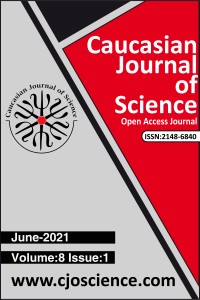Abstract
Öz: Bu çalışma Konya’da bir eğitim ve araştırma hastanesi çalışanlarının sağlık okuryazarlık düzeylerini ve ilişkili faktörleri belirlemek amacıyla yapılmış kesitsel bir çalışmadır. Araştırma Sağlık Bakanlığı’na bağlı bir hastanede görev yapan çalışanlar ile Eylül 2018-Mayıs 2019 tarihleri arasında yürütülmüştür. Araştırmanın evrenini 3239 kişi; örneklemi ise 1081 kişi oluşturmuştur. Araştırmada veri toplama aracı olarak 17 soruluk anket formu ve Avrupa Sağlık Okuryazarlığı Ölçeği kullanılmıştır. Elde edilen veriler SPSS 21.0 programında ve bilgisayar ortamında değerlendirilmiştir. Verilerin değerlendirilmesinde; tanımlayıcı istatistiksel analizler (Aritmetik Ortalama, standart sapma, sıklık, yüzdelik), t testi, One Way ANOVA, Pearson Correlation test kullanılmıştır. Araştırmanın bağımsız değişkenleri bireylerin özellikleri, bağımlı değişkeni ise Avrupa Sağlık Okuryazarlığı Ölçeği puanıdır. Araştırma sonuçlarından elde edilen bulgulara göre; katılımcıların % 53,7’si erkek, % 46,3’ü kadın; yaş ortalaması 34,76±7,80’dir. Katılımcıların %74,3’ü evli, %49,6’sı lisans ve üstü eğitim düzeyine sahip, %49,1’i sürekli işçi kadrosunda, %49,4’ü en uzun süre büyük şehirde yaşamış, %51,4’ünün geliri giderine denktir ve çalışma yılları 9,81±6,97’dir. Yüksek eğitim düzeyine sahip olanların, doktor veya hemşire olanların, yüksek gelir düzeyine sahip olanların, iyi düzeyde sağlığa sahip olanların, kitap okuyanların ve sağlık okuryazarlığı kavramını bilenlerin sağlık okuryazarlığı düzeyi yüksek bulunmuştur. Bu sonuçlar doğrultusunda farklı örneklem gruplarında sağlık okuryazarlığı düzeylerinin değerlendirilmesi; risk gruplarına yönelik eğitici aktivitelere yer verilmesi önerilebilir.
Keywords
Supporting Institution
Aydın Adnan Menderes Üniversitesi Bilimsel Araştırma Projeleri Birimi
Project Number
HF-18015
References
- Abacıgil F., Harlak H., Okyay P. (2016). Türkiye Sağlık Okuryazarlığı Ölçekleri Güvenirlik ve Geçerlilik Çalışması. Ankara Sağlık Bakanlığı Yayınları, 45-73.
- Akbolat M., Kahraman G., Erigüç G., Sağlam H. (2016). Sağlık okuryazarlığı hasta- hekim ilişkisini etkiler mi? sakarya ilinde bir araştırma. TAF Preventive Medicine Bulletin, 15(4), 354- 362.
- Almaleh R., Helmy Y., Farhat E., Hasan H. (2017). Assessment of health literacy among outpatient clinics attendees at Ain Shams University Hospitals, Egypt: a cross-sectional study. Public Health, 151, 137-145.
- Aslantekin F., Uluşen M., Kaplan B., Uysal M. (2013). An evaluation of health literacy situations of patients with type 2 diabetes. Medical Journal of Islamic World Academy of Sciences, 21(3), 105-14.
- Balçık P.Y., Taşkaya S., Şahin B. (2014). Sağlık okur-yazarlığı. TAF Prev Med Bull, 13(4), 321-326.
- Bilir N. (2014). Sağlık okur-yazarlığı. Turkish Journal of Public Health, 12(1), 61-68.
- Chajaee F., Pirzadeh A., Hasanzadeh A., Mostafavi F. (2018). Relationship between health literacy and knowledge among patients with hypertension in Isfahan province, Iran. Electronic Physician, 10(3), 6470-6477.
- Ciccarelli S.L., West P., Bremmeyr K., Savoy-Moore R.T. (2010). Health literacy ınstruments in family medicine: the “newest vital sign” ease of use and correlates. Journal of the American Board of Family Medicine, 23, 195-203.
- Çatı K., Karagöz Y., Yalman F., Öcel Y. (2018). Sağlık okuryazarlığının hasta memnuniyeti üzerine etkisi. Ekonomik ve Sosyal Araştırmalar Dergisi, 14(1), 87-99.
- Demirli P. (2018). Bireylerin Sağlık Okuryazarlığı Üzerine Bir Araştırma: Edirne İli Örneği Yükseklisans Tezi, Trakya Üniversitesi, Sosyal Bilimler Enstitüsü, Edirne.
- Duong T.V., Aringazina A., Baisunova G., Nurjanah., Pham TV., Pham KM et al. (2017a). Measuring health literacy in Asia: Validation of the HLS-EU-Q47 survey tool in six Asian countries. Journal Of Epidemiology, 27(2), 80-86.
- Duong T.V., Chang P.W., Yang SH., Chen MC., Chao WT., Chen T., et al. (2017b). A new comprehensive short-form health literacy survey tool for patients in general. Asian Nursing Research, 11(1), 30-35.
- Ishikawa H., Yano E. (2008). Patient health literacy and participation in the health-care process. Health Expectations, 11, 113–122.
- Kanj M., Mitic W. (2009). Health Literacy and Health Promotion Definitions. 7th Global Conference on Health Promotion, 1(46), 5-13.
- Kendir C., Akkaya K., Arslantaş İ., Kartal M. (2017). Dokuz Eylül Üniversitesi, tıp ve hemşirelik fakültelerine başvuran öğrencilerin sağlık okuryazarlık düzeyi. TJFMPC, 11(3), 51-62.
- Kobayashi L.C., Wardle J., Wolf M.S. (2015). Cognitive function and health literacy decline in a cohort of aging English adults. J Gen Intern Med., 30(7), 958-964.
- Matsumoto M., Nakayama K. (2017). Development of the health literacy on social determinants of health questionnaire in Japanese adults. BMC Public Health, 17(1), 48-51.
- Morris N.S., Mac Lean C.D., Littenberg B. (2013). Change in health literacy over 2 years in older adults with diabetes. The Diabetes Educator, 39(5), 638- 646.
- Ölmez E.H., Barkan O.B. (2015). Sağlık okuryazarlık düzeylerinin belirlenmesi ve hasta hekim ilişkisinin değerlendirilmesi. Balkan Sosyal Bilimler Dergisi, 4(8), 121-127.
- Paasche-Orlow M.K., Wolf., M.S. (2007). The causal pathways linking health literacy to health outcomes. American Journal of Health Behavior, 31, 19-26.
- Pelikan J.M., Röthlın F., Ganahl K. (2012). Comperative Report on Health Literacy in Eight EU Member States. The European Health Literacy Project, 31-33.
- Silk K.J., Sherry J., Winn B., Keesecker N., Horodynski MA., Sayir A. (2010). Increasing nutrition literacy: testing the effectiveness of print, web site, and game modalities. Journal of Nutrition Education and Behavior, 40, 3-10.
- Sorensan K., Van den Broucke S., Pelikan J.M., Fullam J., Doyle G., Slonska Z, et al. (2013). Measuring health literacy in populations: illuminating the design and development process of the European Health Literacy Survey Questionnaire (HLS-EU-Q). BMC Public Health, 13(1), 948.
- Sur H, Palteki T. (2014). Hastane Yönetimi. İstanbul:Nobel Tıp Kitapevi, 56-61.
- Tanrıöver M.D., Yıldırım H.H., Demiray Ready N., Çakır B., Akalın E. (2014). Türkiye sağlık okuryazarlığı araştırması. 1st ed. Ankara: Sağlık-Sen Yayınları; 96.
- Vernon J.A., Trujillo A., Rosenbaum S., De Buono B. (2007). Low Health Literacy: Imlications for National Policy. George Washington University. http://publichealth.gwu.edu/departments/healthpolicy/CHPR/downloads/LowHeal thLiteracyReport10_4_07.pdf.2007, Published 2007. Accessed October 6 2018.
- WEB 1. World Health Organization. World Health Statistics, Indicator compendium. https://apps.who.int/iris/bitstream/handle/10665/43241/9241593261.pdf;jsessionid=6E5DD71C5EAE150F45FF329DE32E1B24?sequence=1. Published 2005. Accessed (May 20 2019).
- WEB 2. World Health Organization. World Health Statistics, Indicator compendium. https://www.who.int/gho/publications/world_health_statistics/WHS2013_IndicatorCompendium.pdf?ua=1. Published 2013. Accessed (December 25 2019).
- WEB 3. World Health Organization. World Health Statistics, Indicator compendium. https://www.who.int/gho/publications/world_health_statistics/2016/EN_WHS2016_TOC.pdf?ua=1. Published 2016. Accessed (December 2 2019).
Abstract
Abstract: This study is a cross-sectional study conducted to determine the health literacy levels of an education and research hospital personnel and related factors in Konya. The research was carried out between September 2018 and May 2019 with personnel working in a hospital affiliated to the Ministry of Health. The population of the study was 3239 people and the sample was 1081 people. In the research, a questionnaire form with 17 questions and the European Health Literacy Scale were used as data collection tools.
The data obtained were evaluated in SPSS 21.0 program and computer medium. Descriptive statistical analyzes (Arithmetic Mean, standard deviation, frequency, percentage), t test, One Way ANOVA, Pearson Correlation test were used in the evaluation of the data. The independent variables of the study are the characteristics of individuals and the dependent variable is the European Health Literacy Scale score. According to the findings obtained from the research results, 53.7% of the participants are male, 46.3% are female and the average age is 34.76 ± 7.80. Of the participants, 74.3% are married, 49.6% have a bachelor's degree and above, 49.1% are permanent workers, 49.4% have lived in the largest city for the longest time, 51.4% had an income equivalent to their expenses and the working years are 9.81 ± 6.97. The health literacy level of those with higher education levels, those who are doctors or nurses, those with high income levels, those with good health, those who read books and those who know the concept of health literacy were found to be high. In line with these results, it can be suggested to evaluate the health literacy levels in different sample groups and to include educational activities for risk groups.
Keywords
Project Number
HF-18015
References
- Abacıgil F., Harlak H., Okyay P. (2016). Türkiye Sağlık Okuryazarlığı Ölçekleri Güvenirlik ve Geçerlilik Çalışması. Ankara Sağlık Bakanlığı Yayınları, 45-73.
- Akbolat M., Kahraman G., Erigüç G., Sağlam H. (2016). Sağlık okuryazarlığı hasta- hekim ilişkisini etkiler mi? sakarya ilinde bir araştırma. TAF Preventive Medicine Bulletin, 15(4), 354- 362.
- Almaleh R., Helmy Y., Farhat E., Hasan H. (2017). Assessment of health literacy among outpatient clinics attendees at Ain Shams University Hospitals, Egypt: a cross-sectional study. Public Health, 151, 137-145.
- Aslantekin F., Uluşen M., Kaplan B., Uysal M. (2013). An evaluation of health literacy situations of patients with type 2 diabetes. Medical Journal of Islamic World Academy of Sciences, 21(3), 105-14.
- Balçık P.Y., Taşkaya S., Şahin B. (2014). Sağlık okur-yazarlığı. TAF Prev Med Bull, 13(4), 321-326.
- Bilir N. (2014). Sağlık okur-yazarlığı. Turkish Journal of Public Health, 12(1), 61-68.
- Chajaee F., Pirzadeh A., Hasanzadeh A., Mostafavi F. (2018). Relationship between health literacy and knowledge among patients with hypertension in Isfahan province, Iran. Electronic Physician, 10(3), 6470-6477.
- Ciccarelli S.L., West P., Bremmeyr K., Savoy-Moore R.T. (2010). Health literacy ınstruments in family medicine: the “newest vital sign” ease of use and correlates. Journal of the American Board of Family Medicine, 23, 195-203.
- Çatı K., Karagöz Y., Yalman F., Öcel Y. (2018). Sağlık okuryazarlığının hasta memnuniyeti üzerine etkisi. Ekonomik ve Sosyal Araştırmalar Dergisi, 14(1), 87-99.
- Demirli P. (2018). Bireylerin Sağlık Okuryazarlığı Üzerine Bir Araştırma: Edirne İli Örneği Yükseklisans Tezi, Trakya Üniversitesi, Sosyal Bilimler Enstitüsü, Edirne.
- Duong T.V., Aringazina A., Baisunova G., Nurjanah., Pham TV., Pham KM et al. (2017a). Measuring health literacy in Asia: Validation of the HLS-EU-Q47 survey tool in six Asian countries. Journal Of Epidemiology, 27(2), 80-86.
- Duong T.V., Chang P.W., Yang SH., Chen MC., Chao WT., Chen T., et al. (2017b). A new comprehensive short-form health literacy survey tool for patients in general. Asian Nursing Research, 11(1), 30-35.
- Ishikawa H., Yano E. (2008). Patient health literacy and participation in the health-care process. Health Expectations, 11, 113–122.
- Kanj M., Mitic W. (2009). Health Literacy and Health Promotion Definitions. 7th Global Conference on Health Promotion, 1(46), 5-13.
- Kendir C., Akkaya K., Arslantaş İ., Kartal M. (2017). Dokuz Eylül Üniversitesi, tıp ve hemşirelik fakültelerine başvuran öğrencilerin sağlık okuryazarlık düzeyi. TJFMPC, 11(3), 51-62.
- Kobayashi L.C., Wardle J., Wolf M.S. (2015). Cognitive function and health literacy decline in a cohort of aging English adults. J Gen Intern Med., 30(7), 958-964.
- Matsumoto M., Nakayama K. (2017). Development of the health literacy on social determinants of health questionnaire in Japanese adults. BMC Public Health, 17(1), 48-51.
- Morris N.S., Mac Lean C.D., Littenberg B. (2013). Change in health literacy over 2 years in older adults with diabetes. The Diabetes Educator, 39(5), 638- 646.
- Ölmez E.H., Barkan O.B. (2015). Sağlık okuryazarlık düzeylerinin belirlenmesi ve hasta hekim ilişkisinin değerlendirilmesi. Balkan Sosyal Bilimler Dergisi, 4(8), 121-127.
- Paasche-Orlow M.K., Wolf., M.S. (2007). The causal pathways linking health literacy to health outcomes. American Journal of Health Behavior, 31, 19-26.
- Pelikan J.M., Röthlın F., Ganahl K. (2012). Comperative Report on Health Literacy in Eight EU Member States. The European Health Literacy Project, 31-33.
- Silk K.J., Sherry J., Winn B., Keesecker N., Horodynski MA., Sayir A. (2010). Increasing nutrition literacy: testing the effectiveness of print, web site, and game modalities. Journal of Nutrition Education and Behavior, 40, 3-10.
- Sorensan K., Van den Broucke S., Pelikan J.M., Fullam J., Doyle G., Slonska Z, et al. (2013). Measuring health literacy in populations: illuminating the design and development process of the European Health Literacy Survey Questionnaire (HLS-EU-Q). BMC Public Health, 13(1), 948.
- Sur H, Palteki T. (2014). Hastane Yönetimi. İstanbul:Nobel Tıp Kitapevi, 56-61.
- Tanrıöver M.D., Yıldırım H.H., Demiray Ready N., Çakır B., Akalın E. (2014). Türkiye sağlık okuryazarlığı araştırması. 1st ed. Ankara: Sağlık-Sen Yayınları; 96.
- Vernon J.A., Trujillo A., Rosenbaum S., De Buono B. (2007). Low Health Literacy: Imlications for National Policy. George Washington University. http://publichealth.gwu.edu/departments/healthpolicy/CHPR/downloads/LowHeal thLiteracyReport10_4_07.pdf.2007, Published 2007. Accessed October 6 2018.
- WEB 1. World Health Organization. World Health Statistics, Indicator compendium. https://apps.who.int/iris/bitstream/handle/10665/43241/9241593261.pdf;jsessionid=6E5DD71C5EAE150F45FF329DE32E1B24?sequence=1. Published 2005. Accessed (May 20 2019).
- WEB 2. World Health Organization. World Health Statistics, Indicator compendium. https://www.who.int/gho/publications/world_health_statistics/WHS2013_IndicatorCompendium.pdf?ua=1. Published 2013. Accessed (December 25 2019).
- WEB 3. World Health Organization. World Health Statistics, Indicator compendium. https://www.who.int/gho/publications/world_health_statistics/2016/EN_WHS2016_TOC.pdf?ua=1. Published 2016. Accessed (December 2 2019).
Details
| Primary Language | Turkish |
|---|---|
| Journal Section | Caucasian Journal of Science |
| Authors | |
| Project Number | HF-18015 |
| Publication Date | June 30, 2021 |
| Submission Date | June 29, 2020 |
| Acceptance Date | June 24, 2021 |
| Published in Issue | Year 2021 Volume: 8 Issue: 1 |








